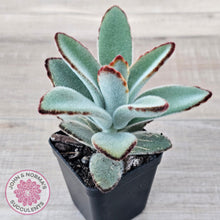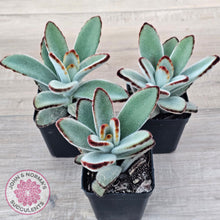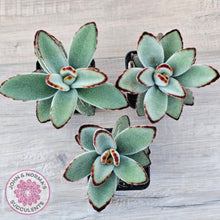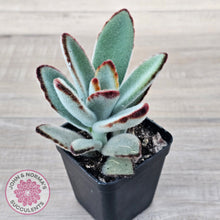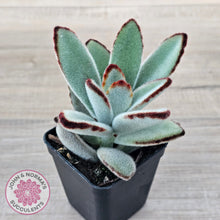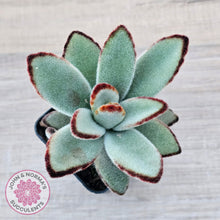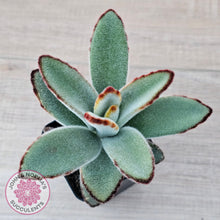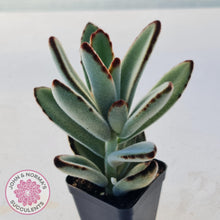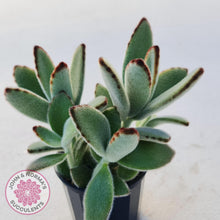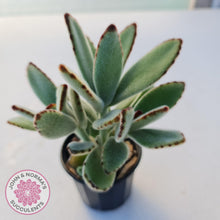
Introducing Kalanchoe Tomentosa: The Panda Plant
Kalanchoe tomentosa, affectionately known as the Panda Plant, is a strikingly unique succulent that hails from the arid terrains of Madagascar. Belonging to the Crassulaceae family, this plant is a resilient grower in both rocky landscapes and indoor succulent displays. As a small, upright shrub, it can achieve heights of 35-45 cm, making it a versatile addition to rock gardens or indoor settings.
Its leaves are the plant's pièce de résistance: thick, spoon-shaped, and adorned with chocolate-coloured notches. These leaves are densely packed with whitish to blue-green hairs, scientifically termed trichomes, which perform an essential function in water conservation by reducing water vapor loss and reflecting sunlight to prevent overheating. This foliage feature also lends the Panda Plant its soft, velvety texture and a plush, furry appearance that's impossible to ignore.
The Panda Plant doesn't just stop at captivating foliage; it also boasts small, greenish-white flowers arranged in a narrow panicle, primarily blooming during the summer months, adding a subtle but delightful burst of color. With a wide range of captivating cultivars such as 'Chocolate Soldier', 'Golden Girl', and 'Teddy Bear', each brings its own unique charm and aesthetic variation.
Renowned for its adaptability and aesthetic qualities, the Panda Plant has earned the prestigious Royal Horticultural Society's Award of Garden Merit. Australian gardeners will find this drought-tolerant plant particularly suitable for regions that closely mimic its native, arid environment.
Whether you're new to the world of succulents or a seasoned gardener, Kalanchoe tomentosa offers both visual intrigue and ease of care, making it a superb choice for anyone looking to add a touch of botanical uniqueness to their green spaces.
Botanical Characteristics and Scientific Classification
Scientific Classification
- Kingdom: Plantae
- Order: Saxifragales
- Family: Crassulaceae
- Genus: Kalanchoe
- Species: K. tomentosa
The first thing one notices about the Panda Plant is its leaves—fleshy, spoon-shaped, and densely covered in tiny, silvery hairs. These hairs contribute to a greyish hue and a texture that's irresistibly soft to the touch. It's almost as if each leaf wears its own coat of fur.
But the Panda Plant isn't just a one-trick pony; it also produces flowers. These flowers are small, tubular, and tend to be a pale yellow. They emerge from long, upright stalks and bloom primarily during late winter to early spring.
The plant stands on a sturdy, woody stem, which supports the weight of the leaves. Over time, as the Panda Plant matures, it can reach heights of up to 60 cm.
Mastering Care: Light, Water, Soil, and More
Light Requirements
Panda Plants are sun-loving creatures that thrive in bright, indirect light. A window sill facing east or west would be an ideal spot. Too much direct sunlight can cause scorching of the leaves, but a lack of light can lead to elongated, pale foliage—a condition known botanically as etiolation.
Watering Techniques
As with many succulents, the Panda Plant's watering needs are minimal. Water the plant sparingly, making sure to let the soil dry out entirely between watering. Overwatering can lead to root rot, a fatal condition for succulents.
When it comes to the frequency of watering, it can vary depending on the climate and the specific growing conditions in your area. In hot, dry conditions, you might need to water it once every two weeks, while in more temperate climates, once a month may suffice. Always check the soil's moisture level before watering.
Soil Preferences
It’s crucial to use well-draining soil, preferably a cactus or succulent mix, for your Panda Plant. The ideal pH balance should be slightly acidic to neutral, ranging between 6 to 7.
Propagation Insight
Propagation of the Panda Plant is usually carried out through leaf cuttings. However, the process is a bit more intricate than merely plucking a leaf and planting it. After taking a leaf cutting, it is crucial to let it callous over for at least a week to avoid rotting when planted. Once the leaf has properly callused, lay it flat on the soil, as this encourages the roots and new shoots to develop more evenly and efficiently. Water minimally, being careful not to wet the leaf itself, which can lead to rot, until you see new growth. This is a sign that the leaf has rooted successfully.
Temperature and Humidity
Panda Plants prefer a moderate temperature range of 18-24°C and can tolerate dry air quite well, but they don’t fare well in extremely humid environments.
Cultivars and Common Names
-
Cultivars: Over the years, selective breeding has resulted in a few distinct cultivars worth mentioning. K. 'Chocolate Soldier' is loved for its darker, almost cocoa-colored leaves. K. 'Golden Girl' has a lighter hue, reminiscent of a sun-kissed morning. K. 'Teddy Bear' is similar in coloration to the original Panda Plant but has a more compact growth habit. Kalanchoe tomentosa 'Dorothy Brown' is similar in appearance to K. 'Chocolate Soldier' but known for its distinctively rich brown and reddish colouring.
-
Common Names: In various parts of the world, the Panda Plant is also known by different names such as "Pussy Ears," "Chocolate Soldier," and "Teddy Bear Plant."
Little Known Facts and Extra Tips
Although the Panda Plant is relatively easy to care for, there are a few tips that could optimize its growth even further:
-
If you’re living in a more humid environment, consider using a dehumidifier or placing your Panda Plant in a room with lower humidity.
-
Do not mist the leaves as this can lead to fungal infections. This is particularly true for Panda Plants due to their fuzzy leaf surface, which can trap moisture.
-
For those interested in the more scientific aspects, Kalanchoe tomentosa belongs to the Crassulaceae family, which includes a wide variety of other easy-to-care-for plants perfect for beginner gardeners.
Kalanchoe tomentosa "Panda Plant" plants for sale shown in 70mm pot. You will receive same or similar plants to those shown in images. Colours will vary depending on time of year and growing conditions.
First time customers... Please read our Shipping Guide, in top or bottom menu, before placing your order.
Please Note:
- All plants are sent bare rooted with no pots and soil, or minimum soil only.
- Due to the drying process necessary for sending plants through the mail, plants may look slightly different than images shown on our website
- Some plants, may look wrinkled when they arrive, may be somewhat limp, or soft to the touch. This is normal as they have been dried out for for a number of days before shipping to avoid rotting in the mail.
- Succulents are very hardy plants and they will recover quickly, providing you unpack them as soon as you receive them follow some simple care instructions you will find with your order.
If you have any questions or concerns at all, please message us via our Facebook page at John & Norma's Succulents for the fastest Response.













